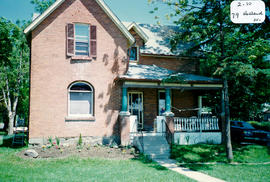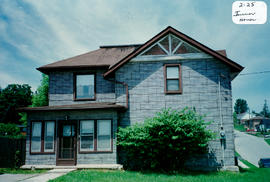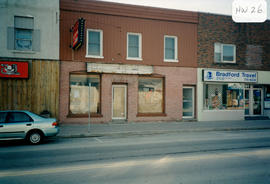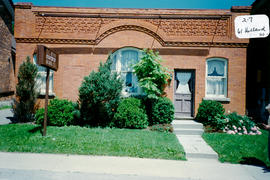- CA BWGPL GJ-HB-2017-04-01-03
- Pièce
- 1996
Fait partie de George Jackson fonds
The building located at 79 Holland St. West (on the northeast corner of Holland and Church Streets) was built in the Gothic Revival style around 1890-1910. Wilton Johnson and Irwin Ray, retired farmers, once lived in this house. Wilton worked for years for the Clubines. The previous owner was a tombstone maker who sold tombstones throughout all of Simcoe County.
The two-storey, ‘L’-shaped building has a medium-pitched, gable roof with a gable dormer. This is a typical Gothic Revival feature. Uncharacteristically, however, the dormer eaves do not align with the main roof eaves. A broad, hipped, Regency-like porch roof is supported by an eclectic mixture of forms (including a broad cornice band and half, Doric columns on brick pilasters). The porch railing and stairs are not original. There is a coloured-glass, arched transom over the main-floor, gable-end window. The ground-floor windows are wider than those at the second floor. The house has loadbearing, brick masonry construction and a stone foundation. According to the 2000 inventory, the building is an eclectic mixture of styles (suggesting early twentieth-century construction). It also notes that the modern door and railings are unsympathetic with the original design. (1, 2, 3)
Sans titre







